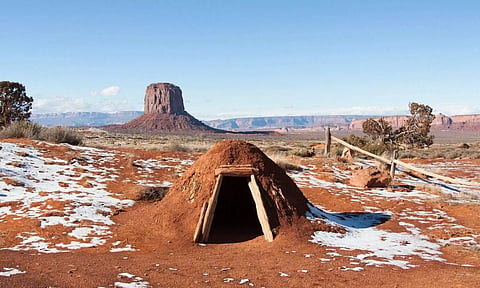

Katrina Miller
UNITED STATES: On Oct 14, an annular eclipse will make its way across the Western Hemisphere. The moon, farther from Earth than during a total eclipse, will block much of our view of the sun, leaving only a fiery halo of light in a darkened sky.
In the United States, the show begins in Oregon, then cuts through the Southwest before exiting through the Texas coastline. It will then cut across the Yucatan Peninsula in Mexico and through Central America, before dipping down into Colombia, passing through the Amazon basin and concluding along Brazil’s eastern coast.
Thousands of tourists are flocking to the path of annularity to catch this astronomical marvel, which will last about four minutes at any given point along the path.
Many describe eclipses as spiritual experiences. But there’s at least one place where people can’t venture to watch: the sprawling desert lands of Navajo Nation, whose tribal parks in Arizona, New Mexico and Utah might have made a beautiful backdrop for the public to view a celestial “ring of fire.”
On Sept. 15, Navajo Nation Parks & Recreation announced that all parks would be closed during the eclipse to accommodate traditional beliefs.
“Navajo look at the universe as holistic,” said David Begay, a cultural astronomer and vice president of the Indigenous Education Institute. The alignment of the planet, moon and sun during eclipses is understood as one cycle within an interconnected cosmic order, said Dr. Begay, who is Dine (which Navajo people call themselves).
The park closures are a reminder that for Indigenous peoples across the Americas, eclipses and other astronomical phenomena have been experienced for millenniums and have played important roles in different cultures.
Traditions like those in Navajo Nation represent a call for non-Native tourists to be respectful when visiting sacred Indigenous lands and sites.
And those encountering the eclipse in other parts of the Americas may also pause and consider peoples who made their homes among the canyons of the Southwest, around the pyramids of Mexico and Central America and in the rainforests of Brazil; and how the stars, planets and other heavenly bodies manifest in the lives of Indigenous communities.
In 2017 when a total solar eclipse traveled across the United States, an estimated 88 percent of American adults observed the event in some way.
The experience differed in Navajo Nation. Schools closed, employees were granted administrative leave, and people were encouraged to maintain “stillness in their homes, and not partake of food and water,” according to a memo from tribal leaders.
Dr. Begay has a distinct memory of driving down a road on the border of Navajo Nation in the hours leading up to an annular eclipse in 2012. Crowds of people were setting up telescopes along the highway. “It was like that all the way up to the reservation border,” he said.
But once he crossed the line, the land was devoid of people until he made it to the other side hours later. Rather than a spectacle, many on the reservation saw the eclipse as a time for reverence and reflection.
Semira Crank, a Dine program director at the Bears Ears Partnership in southeast Utah, was taught during her upbringing to not look at an eclipse for two reasons. The first is practical: Looking at the sun can damage your eyes.
But the other reason, she said, is that doing so can disrupt a person’s Hozho, or spiritual harmony. “It goes back to our origin stories,” Crank said.